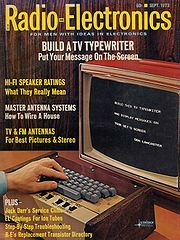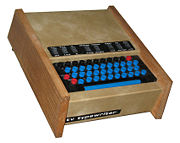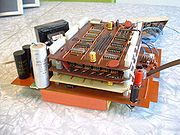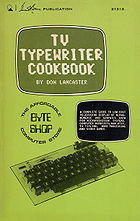
TV Typewriter
Encyclopedia

Television set
A television set is a device that combines a tuner, display, and speakers for the purpose of viewing television. Television sets became a popular consumer product after the Second World War, using vacuum tubes and cathode ray tube displays...
. The Don Lancaster
Don Lancaster
Donald E. Lancaster is a prolific author, inventor, and microcomputer pioneer best known for his magazine columns. He is also known for his "TV Typewriter" dumb terminal project, his book on technical entrepreneurship The Incredible Secret Money Machine, and his work on and advocacy of early...
design appeared on the cover of Radio-Electronics
Radio-Electronics
Radio-Electronics was an American electronics magazine that was published under various titles from 1929 to 2003. Hugo Gernsback started it as Radio-Craft in July 1929. The title was changed to Radio-Electronics in October 1948 and again to Electronics Now in July 1992. In January 2000 it was...
magazine in September 1973. The magazine included a 6 page description of the design but readers could send off for a 16 page package of construction details. Radio-Electronics sold thousands of copies for $2.00 each. The TV Typewriter is considered a milestone in the home computer revolution along with the Mark-8
Mark-8
The Mark-8 is a microcomputer design from 1974, based on the Intel 8008 CPU . The Mark-8 was designed by graduate student Jonathan Titus and announced as a 'loose kit' in the July 1974 issue of Radio-Electronics magazine.- Project kit :The Mark-8 was introduced as a 'build it yourself' project in...
and Altair 8800
Altair 8800
The MITS Altair 8800 was a microcomputer design from 1975 based on the Intel 8080 CPU and sold by mail order through advertisements in Popular Electronics, Radio-Electronics and other hobbyist magazines. The designers hoped to sell only a few hundred build-it-yourself kits to hobbyists, and were...
computers.
TVT I


Goodyear Aerospace
Goodyear Aerospace Corporation was the aerospace and defense subsidiary of Goodyear.-Early Years:The company began as Goodyear Tire & Rubber Co.’s Aeronautics Department and renamed in 1917 as the Goodyear Zeppelin Corporation set up to construct dirigibles for the US military...
designing a high resolution video display for the military. Don was also a prolific author of hobbyist projects for Popular Electronics
Popular Electronics
Popular Electronics was an American magazine started by Ziff-Davis Publishing in October 1954 for electronics hobbyists and experimenters. It soon became the "World's Largest-Selling Electronics Magazine". The circulation was 240,151 in April 1957 and 400,000 by 1963. Ziff-Davis published Popular...
and Radio-Electronics
Radio-Electronics
Radio-Electronics was an American electronics magazine that was published under various titles from 1929 to 2003. Hugo Gernsback started it as Radio-Craft in July 1929. The title was changed to Radio-Electronics in October 1948 and again to Electronics Now in July 1992. In January 2000 it was...
magazines. The video project gave Don the inspiration for his most influential project, a low cost video terminal known as the TV Typewriter. The design used TTL digital logic and shift register
Shift register
In digital circuits, a shift register is a cascade of flip flops, sharing the same clock, which has the output of any one but the last flip-flop connected to the "data" input of the next one in the chain, resulting in a circuit that shifts by one position the one-dimensional "bit array" stored in...
memory. (Microprocessors and RAM were new and very expensive.) With professional terminals costing over $1000 this $120 kit looked like a bargain. Southwest Technical Products
SWTPC
The U.S. company SWTPC started in 1964 as DEMCO . It was incorporated in 1967 as Southwest Technical Products Corporation of San Antonio, Texas...
sold the set of bare circuit boards for $27 and the eight major integrated circuits for $49.50. The hobbyist had to acquire the rest of the components on their own.
In the November issue, the editors apologized for the delays in shipping the TV Typewriter booklets to the thousands of readers that ordered them. They also listed electronics parts sources for the difficult to find components. Don Lancaster also answered a series of reader questions and gave ideas for additional functions and uses for the TV Typewriter. The December issue had a page of corrections for the TV Typewriter booklet. Both of the notices were included in later printings of the booklet.
The compact design and complex circuitry made the TV Typewriter a challenging project for hobbyists. But many finished the project and some even connected it to their Intel 8008
Intel 8008
The Intel 8008 was an early byte-oriented microprocessor designed and manufactured by Intel and introduced in April 1972. It was an 8-bit CPU with an external 14-bit address bus that could address 16KB of memory...
based computers. The April 1975 issue of the Micro-8 Newsletter has 6 pages of user modifications and interface designs to connect the TV Typewriter to Mark-8
Mark-8
The Mark-8 is a microcomputer design from 1974, based on the Intel 8008 CPU . The Mark-8 was designed by graduate student Jonathan Titus and announced as a 'loose kit' in the July 1974 issue of Radio-Electronics magazine.- Project kit :The Mark-8 was introduced as a 'build it yourself' project in...
or SCELBI
SCELBI
SCELBI Computer Consulting was a personal-computer hardware and software manufacturer located in Milford, Connecticut. It was founded in 1973 by Nat Wadsworth and Bob Findley. Initially, they sold hardware based on the first 8-bit microprocessor from Intel, the 8008...
computers. The original TV Typewriter design did not include a serial interface, modem connection, or offline data storage on cassette tape. Don Lancaster wrote about these in the September 1975 issue of BYTE magazine
Byte (magazine)
BYTE magazine was a microcomputer magazine, influential in the late 1970s and throughout the 1980s because of its wide-ranging editorial coverage...
and his TV Typewriter Cookbook. A serial interface board designed by Roger Smith was published in January 1975 issue of Radio Electronics.
Keyboards
Today keyboards are readily available, inexpensive and have a standard interface. In 1973, new keyboards were only available to computer and terminal manufacturers. Surplus keyboards were available to hobbyists but they often produced codes other than ASCIIASCII
The American Standard Code for Information Interchange is a character-encoding scheme based on the ordering of the English alphabet. ASCII codes represent text in computers, communications equipment, and other devices that use text...
, such as baudot
Baudot code
The Baudot code, invented by Émile Baudot, is a character set predating EBCDIC and ASCII. It was the predecessor to the International Telegraph Alphabet No 2 , the teleprinter code in use until the advent of ASCII. Each character in the alphabet is represented by a series of bits, sent over a...
or EBCDIC. The TV Typewriter project and kit did not include a keyboard. The unit on the September cover shows a keyboard project Don Lancaster did in the February 1973 issue. This project involved hand crafting 55 key-switches including fabricating the springs for each key-switch. Most hobbyists chose to use a surplus keyboard and modified it to produce ASCII codes. Don Lancaster's prototype TV Typewriter which is now on display at the Computer History Museum
Computer History Museum
The Computer History Museum is a museum established in 1996 in Mountain View, California, USA. The Museum is dedicated to preserving and presenting the stories and artifacts of the information age, and exploring the computing revolution and its impact on our lives.-History:The museum's origins...
has a surplus keyboard with an ASCII encoder circuit that was published in the February 1974 issue of Radio-Electronics. The plans for this encoder were also included in the TV Typewriter booklet
Popular Electronics (April 1974) featured a complete keyboard kit designed by Don Lancaster and available from Southwest Technical Products for $39.50. The first version used simple RTL ICs to decode the key matrix. The design was soon improved to use a full featured keyboard encoder IC.
TVT II - CT-1024 Terminal


Daniel Meyer of SWTPC
SWTPC
The U.S. company SWTPC started in 1964 as DEMCO . It was incorporated in 1967 as Southwest Technical Products Corporation of San Antonio, Texas...
enlisted Ed Colle, an engineer who had worked at Datapoint
Datapoint
Datapoint Corporation, originally known as Computer Terminal Corporation , was a computer company based in San Antonio, Texas, United States. Founded in 1967 by Phil Ray and Gus Roche, its first products were, as the company's initial name suggests, computer terminals...
on terminal design, to design the new TV Typewriter. The SWTPC CT-1024 Terminal displayed 32 characters by 16 lines without scrolling. It used common TTL parts and 2102 static RAMS. The boards were laid out with very loose part spacing and wide traces to make it easy to assemble. A complete set of option boards were offered including a serial interface. The keyboard was based on Don Lancaster’s design. The rest of the terminal was done by Ed Colle.
The design was finished by late 1974 and the kits were ready for sale by December 1974. The first advertisement for the CT-1024 appeared in the January 1975 issue of Popular Electronics on the page facing the Altair 8800 computer article. The full page advertisement, "SWTPC is Proud to Announce the CT-1024 Terminal System", appeared on page 32. The Altair 8800 article started on page 33. The CT-1024 was very successful because a complete kit with options cost only $275. It was replaced in 1977 by the improved CT-64 that offered scrolling and 64 character per line of upper and lower case.
TV Typewriter Cookbook

Popular Electronics
Popular Electronics was an American magazine started by Ziff-Davis Publishing in October 1954 for electronics hobbyists and experimenters. It soon became the "World's Largest-Selling Electronics Magazine". The circulation was 240,151 in April 1957 and 400,000 by 1963. Ziff-Davis published Popular...
and Radio-Electronics
Radio-Electronics
Radio-Electronics was an American electronics magazine that was published under various titles from 1929 to 2003. Hugo Gernsback started it as Radio-Craft in July 1929. The title was changed to Radio-Electronics in October 1948 and again to Electronics Now in July 1992. In January 2000 it was...
. He had also written a digital design book titled the RTL Cookbook in 1968. Resistor-transistor logic
Resistor-transistor logic
Resistor–transistor logic is a class of digital circuits built using resistors as the input network and bipolar junction transistors as switching devices...
(RTL) was an early IC technology that was replaced by TTL
Transistor-transistor logic
Transistor–transistor logic is a class of digital circuits built from bipolar junction transistors and resistors. It is called transistor–transistor logic because both the logic gating function and the amplifying function are performed by transistors .TTL is notable for being a widespread...
, so in 1974 he published the TTL Cookbook. This book was in print for 20 years and sold a million copies.
The original TV Typewriter was designed before low cost RAM was available and the design was soon obsolete. Don had made many design improvements and published them as the TV Typewriter Cookbook in 1976. Portions had been serialized in the first issues of Byte magazine
Byte (magazine)
BYTE magazine was a microcomputer magazine, influential in the late 1970s and throughout the 1980s because of its wide-ranging editorial coverage...
. The book was a guide on how to design a video computer terminal.
- Some Basics
- Integrated Circuits for TVT use
- Memory
- System Timing - Calculation and Circuits
- Cursor and Update Circuits
- Keyboards and Encoders
- Serial Interfaces
- Television Interfaces
- Hard Copy and Color Graphics
This book guided many hobbyist and professionals in designing video displays for home computer systems. The cassette interface design from chapter 7 was the basis for the Kansas City Standard
Kansas City standard
The Kansas City Standard , or Byte standard, is a digital data format for audio cassette drives. Byte magazine sponsored a symposium in November 1975 in Kansas City, Missouri to develop a standard for storage of digital computer data on inexpensive consumer quality cassettes, at a time when...
. The circuits in this book did not rely on a microprocessor, just TTL. The TV Cheap Video Cookbook (1978) showed the TVT 6 5/8 that would work with a 6502
MOS Technology 6502
The MOS Technology 6502 is an 8-bit microprocessor that was designed by Chuck Peddle and Bill Mensch for MOS Technology in 1975. When it was introduced, it was the least expensive full-featured microprocessor on the market by a considerable margin, costing less than one-sixth the price of...
or 6800
Motorola 6800
The 6800 was an 8-bit microprocessor designed and first manufactured by Motorola in 1974. The MC6800 microprocessor was part of the M6800 Microcomputer System that also included serial and parallel interface ICs, RAM, ROM and other support chips...
microprocessor. The design was targeted at the KIM-1
KIM-1
The KIM-1, short for Keyboard Input Monitor, was a small 6502-based single-board computer developed and produced by MOS Technology, Inc. and launched in 1976...
Microcomputer.
The original TV Typewriter book cover shows an ASCII keyboard designed by Don Lancaster and sold by Southwest Technical Products. An early computer store chain, the Byte Shop
Paul Terrell
Paul Terrell is the founder of the Byte Shop, one of the first personal computer retailers. He started the store in December 1975 in Mountain View, California.-Byte Shop and Apple:...
, had the publisher add their logo to the covers and sold the TTL Cookbook and the TV Typewriter Cookbook in their stores. A later edition cover was designed for Radio Shack
Radio shack
Radio shack is a slang term for a room or structure for housing radio equipment.-History:In the early days of radio, equipment was experimental and home-built. The first radio transmitters used a noisy spark to generate radio waves and were often housed in a garage or shed. When radio was first...
stores. The ninth printing of the first edition was in 1983.
See also
- Home computerHome computerHome computers were a class of microcomputers entering the market in 1977, and becoming increasingly common during the 1980s. They were marketed to consumers as affordable and accessible computers that, for the first time, were intended for the use of a single nontechnical user...
- Personal computerPersonal computerA personal computer is any general-purpose computer whose size, capabilities, and original sales price make it useful for individuals, and which is intended to be operated directly by an end-user with no intervening computer operator...
- History of computing hardware (1960s-present)History of computing hardware (1960s-present)The history of computing hardware starting at 1960 is marked by the conversion from vacuum tube to solid state devices such as the transistor and later the integrated circuit. By 1959 discrete transistors were considered sufficiently reliable and economical that they made further vacuum tube...
- Character generatorCharacter generatorA character generator, often abbreviated as CG, is a device or software that produces static or animated text for keying into a video stream. Modern character generators are computer-based, and can generate graphics as well as text...

